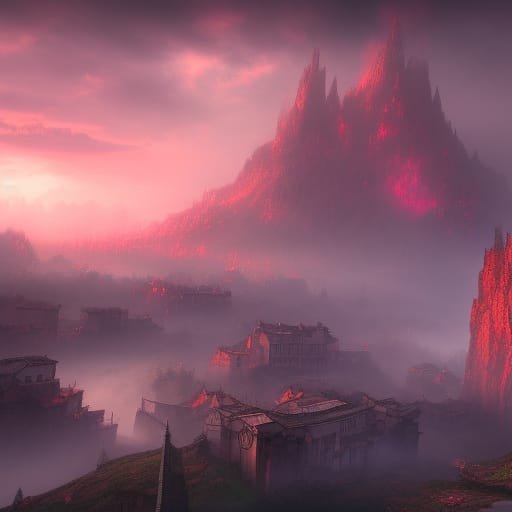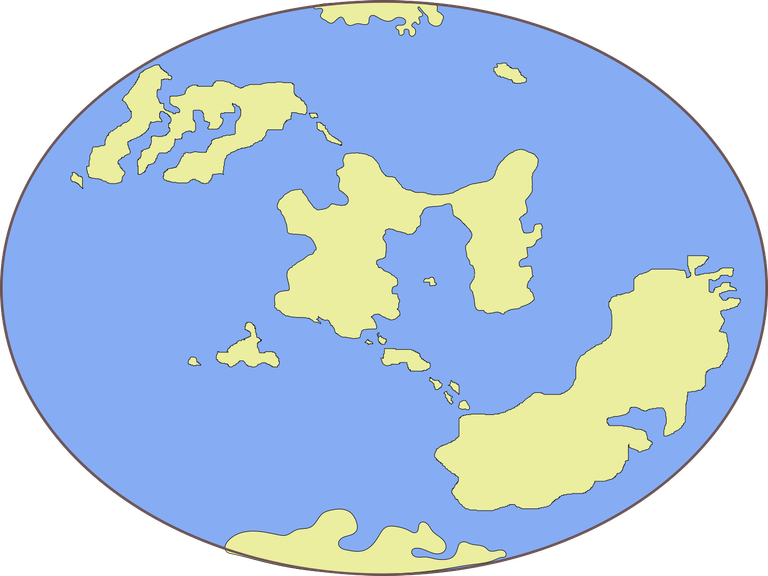(Parent: Arrival of the Core MachinaeParent post)
In this series I will present various aspects of the world in which the Kalavian Tales take place. This world is called Kalavia, and this post will provide a first introduction to it.
Emergence of Kalavia as a planet
Kalavia is a relatively small planet, which has a circumference of about 20,000 km around the equator. It has three moons and a single sun. Two of its moons (Beya and Sidris) and its sun have a CM. Its third moon, Temporis, has no CM but its movement corresponds with the seasons, with each season lasting for precisely three rotations of Temporis around Kalavia.
There are also three other planets in the system: Lanos and Torys are binary planets which are slightly larger and further away, encircled by five additional moons. Elzarus is a pitch black granite rock planet that is similar in size to Kalavia but circles closer to the sun. The sun rises in the east, sets in the west, and changes colour during the seasons (purple in snow, blue in rain, yellow in sun, red in fog, green in wind).
Prior to the arrival of the Core Machinae, Kalavia was a rather hot planet featuring very large creatures. A few primitive races and civilizations existed, such as the Pyrefolk (small humanoid creatures that made a living deep inside volcanoes), and the Flame riders (feral creatures that tamed and rode even larger beasts than themselves.
Overview of major time periods in Kalavian history
- Wild Age (-4B until Year 0)
- Starts with the world emerging (4B years ago)
- Primitive life and basic civilizations form, almost alien in nature.
- Kalavia was a hot planet, with a large number of volcanoes.
- Ends with the arrival of the Core Machinae (the Great Meteorite), 51051 years ago.
- Blue Age (0-27551)
- Starts with first new tribes forming
- Mid-period of feudal wars and religiously inspired clans.
- Ends with the invention of the steam engine in Bolsworth, and the First Global Great War (a battle of religions).
- Red Age (27551-45406)
- War is won by the Iron Alliance, which includes Bolsworth.
- March towards full globe Domination of the Belovian Empire, which steals and profits from Bolsworth secrets, and quickly expands.
- Ends with the Void Cataclysm (pockets appearing without oxygen, excess of red air).

Impression of the Void Cataclysm, where many regions lost breathable air.
- Green Age (45406-51051)
- Anaerobic (Sorx) and aquatic races (Marines) initially rise to prominence
- “Nature-tech” civilization gradually develops, and Pargons grow in power.
- Rise of racism.
- Major showdown between Pargons, Sorx, Humans and Marines ends up in a blood-ridden draw (Second Global Great War).
- Ends when the Second Global Great War ends, and when the Pestilence envelops the globe, killing millions.
- Purple Age (51051-)
- Starts with the great recovery, where poor, tiny civilizations try to re-establish their footing in the world after the Pestilence has begun to recede.
- This is where most of the current stories take place.
The continents today

Here is a blank map of Kalavia. Most of the stories take place on the central continent, Dyjalom. The two other major continents are Alvarene (northwest) and Ulycia (southeast). There are also two smaller arctic continents, Cyclus in the far south, and Nagelin in the far north. More detailed world maps are in the works, and I will share them later as part of this series. Most of the Kalavian Tales take part in the northern section of Dyjalom, just above the big bay which is known as the Central Sea.
Races of note
Lastly, here is a brief listing of the major races in Kalavia
- Humans
- Marines - weaker, more blubbery humanoids who have exceptional endurance and resilience. They have a natural affinity to the sea and can breathe underwater up to a depth of 200m (oxygen levels are too low below it).

Two marines traversing the seas on a small boat.
Green Age races
- Pargons - stronger, more toned humanoids who are more prone to diseases and sensitive to temperature changes. Tend to have white hair.
- Fleres (or Filwai) - batlike humanoids with sonar and poor eyesight. Some have wings, but not all. Light, intelligent, sometimes physically clumsy. Slightly reclusive.
- Felines - catlike humanoids with excellent eyesight and good agility, but a lack of organizational and planning intelligence.
Medusae - brown, scaly humanoids with thick hair and a piercing gaze that can stun or (very occasionally) petrify. Are vulnerable to bronze and crushing blows.
Ancient races
- Archonites (not in Green Age) - while snakelike creatures which are highly intelligent and reclusive. They are useless in combat when unprepared and unaware.
- Sorx - subterannean humanoids who can consume red air (or blue air) and release green air. Survived the CM impact.
- Peons - smaller subterranean humanoids who live in symbiosis with the Sorx. Survived the CM impact.
Hi @wanderingmoon. Just so you know, I started this series by your request :).